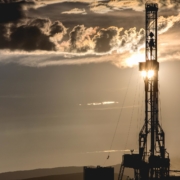DESERT MOUNTAIN ENERGY ANNOUNCES SIGNIFICANT HELIUM PERCENTAGES IN TWO NEW WELLS IN ARIZONA
Vancouver, British Columbia — DESERT MOUNTAIN ENERGY CORP. (the “Company”) (TSX.V: DME, U.S. OTC: DMEHF, Frankfurt: QM01) is pleased to announce that it has tested significant Helium percentages in its new exploratory wells in Arizona.
The company has completed its independent gas analyses on both of its exploratory wells in Arizona, the State 10-1 and State 16-1. In the 10-1 well the company perforated 5 feet of a limey sand in the lower Pennsylvanian-aged Formation out of which the company feels, based on open-hole logs, is a possible productive 28-foot zone with resistivities from 38 to 73 ohms. Well logs delineate a drop in the porosity in the mid portion of this zone, consequently it feels that the additional interval under the current perforations would require separate sets of perforations to produce. Initial shut-in pressure was 900 psi and through the multi-choke flow test, flowing pressure increased to 940 psi on a 1-inch choke with a coefficient of 25.76, equivalent to a non-corrected flow rate of 24,214 MCFGPD. The average gas analysis showed Helium 7.1321%, Nitrogen 77.0837%, CO2 4.0183% Methane 2.6512% and other assorted minor gases.
The 16-1 well also perforated 5 feet of sand in the Supai Formation out of which the company feels, based on open-hole well logs, is a possible 61-foot productive zone. Again, similar to what was found in the 10-1 well, there are two stringers of very dense dolomitic lime dropping the porosity. Additional perforations would be required to access these intervals of possible production. Initial shut-in pressure was 372 psi and through the multi-choke flow test, flowing pressure decreased and then quickly stabilized at 368 psi on a 3/8” choke with a coefficient of 3.40, equivalent to a non-corrected flow rate of 1,251.2 MCFGPD. The average gas analysis showed Helium 4.0904%, Nitrogen 90.2742%, CO2 0.0063%, Methane 3.5535% and other assorted minor gases.
Based on normal accepted industry operation procedures, the company at this time and prior to further engineering and flow testing, would entertain a possible daily flow rate of between 4,100 and 5,600 MCFGPD based on aggregated production from both wells. The Company has compared these wells to the closest established and documented helium production located approximately 35 miles NE in the Pinta Dome Field. Note: Desert Mountain Energy’s wells have been completed in members of the Pennsylvanian-aged Formations which are lower in depth than the helium productive Permian-aged Coconino Formation found at Pinta Dome (AZOGCC archives). Production comparisons with a number of wells from the prolific Pinta Dome Field, specifically the Kerr-McGee Barfoot State#1, clearly shows that large artificial formation stimulation was not required to exceed the original projected calculated reserves by over 500%, over a 13-year production life (Olukoga 2016, AZOGCC Barfoot #1 well files).
The Pinta Dome, Navajo Springs Unit, and East Navajo Springs Unit, in total, comprise only 26 total productive wells (Conley, J.N. 1974). The majority of the production came from Pinta Dome and was from only 11 wells, (AZOGCC production records, Olukoga 2016). Those wells averaged about 8% helium across the field with a high initially noted at 10.78% in one well. The thicknesses of the pay-zones varied greatly from 2’ to just over 103’. Consequently, the overall perforated zones can be misleading, but after eliminating the single thickest pay- zone completion of 73 feet, (Eastern State 1-28, AZOGCC files,) the pay-zone perforations falls to 27 feet. Initial shut-in pressures averaged 172.3 psi and the average flowing pressures averaged 99.3 psi in 1962 and in 1976, the last year of continuous production, was down to 60.3 psi (Rauzi 2003, Olukoga, 2016). Total production from the three fields was just over 9.6 billion cubic feet of total crude gas with approximately 2/3rds produced from the 11 Pinta Dome wells. Actual helium as a percentage of production may vary greatly, as within any given field, as the extent of the productive area is not known at this time.
The company is not seeking to publish reserve estimates at this time, in part due to the fact that both wells have been completed in zones where there is currently no nearby production in Arizona from which to conduct accurate long-term reserve analysis. However, the company will be having an independent review and submit their findings and should the qualified person be unable to report without reservation on reserves data, he shall set out the cause of the reservation and the effect, if known to the qualified reserves evaluator on the reserve data or prospective contingent resources data.
It should be noted that the zones that have been perforated are present on both well logs and reflected on seismic, and therefore do provide some guide that there is a possible extension as both wells are about 1.4 miles apart. With the pressure differential in the formations in the wells, it is not currently possible to commingle production because the lower-pressured zone would simply not produce with the higher-pressured lower zone opened within the same well. Therefore, and in accordance with normal accepted industry guidelines and Arizona State Oil & Gas Conservation Commission rules, no allowance for commingling within the same wellbore would be appropriate or approval granted.
Note that the previously mentioned flow rates may not be the actual daily productive flow rates once actual production is established! Actual productive flow rates may vary from these suggested possible flow rates and future net revenue for individual wells may not reflect the same confidence level as estimates of future reserves on all wells, due to the effects of aggregation.
About Desert Mountain Energy
The Company is an exploratory resource company engaged in exploration and development of helium, oil & gas and mineral properties in the Southwestern United States. Until September 5, 2018, the Company also owned the Yellowjacket Gold Project in Atlin, British Columbia, which it had been developing. The Company has its executive offices in Vancouver, Canada. The Company was incorporated under the laws of the Province of British Columbia, on April 30, 2008, and was formerly named African Queen Mines Ltd. It initially received certain southern African assets in a spin off transaction related to the acquisition of Pan African Mining Corp. by Asia Thai Mining Co., Ltd.
On Behalf of the Board of Directors of Desert Mountain Energy Corp.
“Robert Rohlfing”
Robert Rohlfing
Chairman & CEO
For more information, contact:
Don Mosher, Vice President of Capital Markets
E-mail: don@desertmountainenergy.com
(604) 617-5448
The TSX Venture Exchange has not reviewed and does not accept responsibility for the adequacy or accuracy of the content of the information contained herein. The statements made in this press release may contain certain forward-looking statements that involve a number of risks and uncertainties. Actual events or results may differ from the Company’s expectations.



